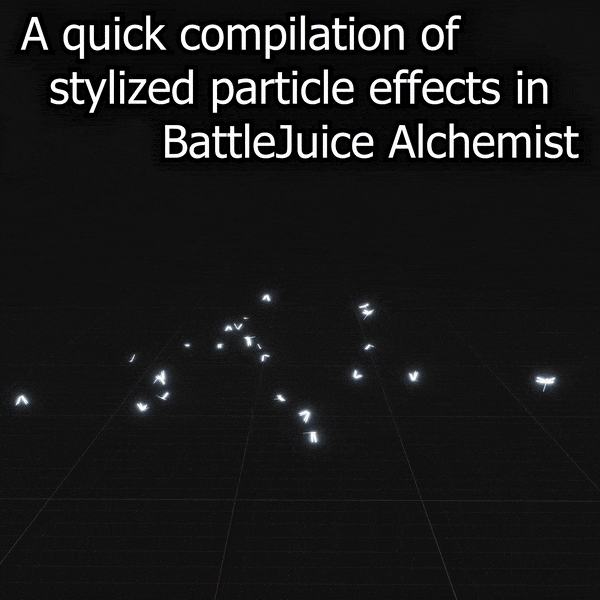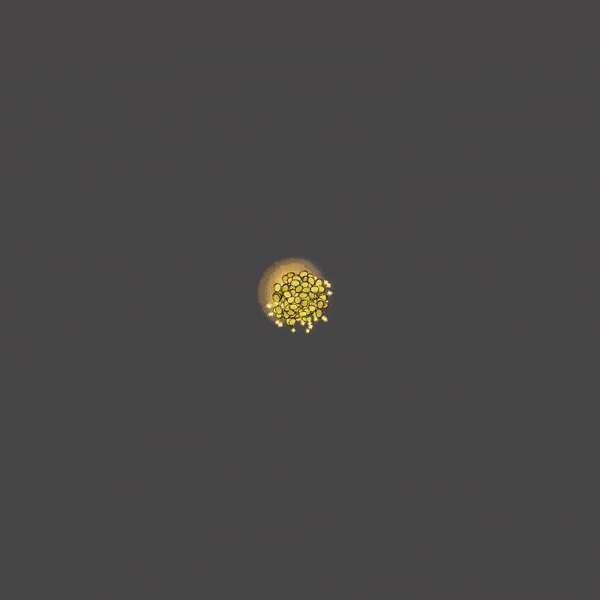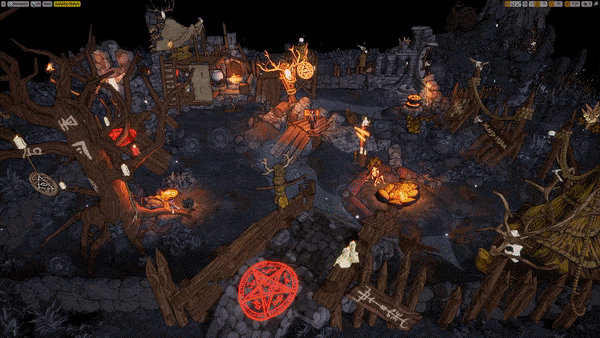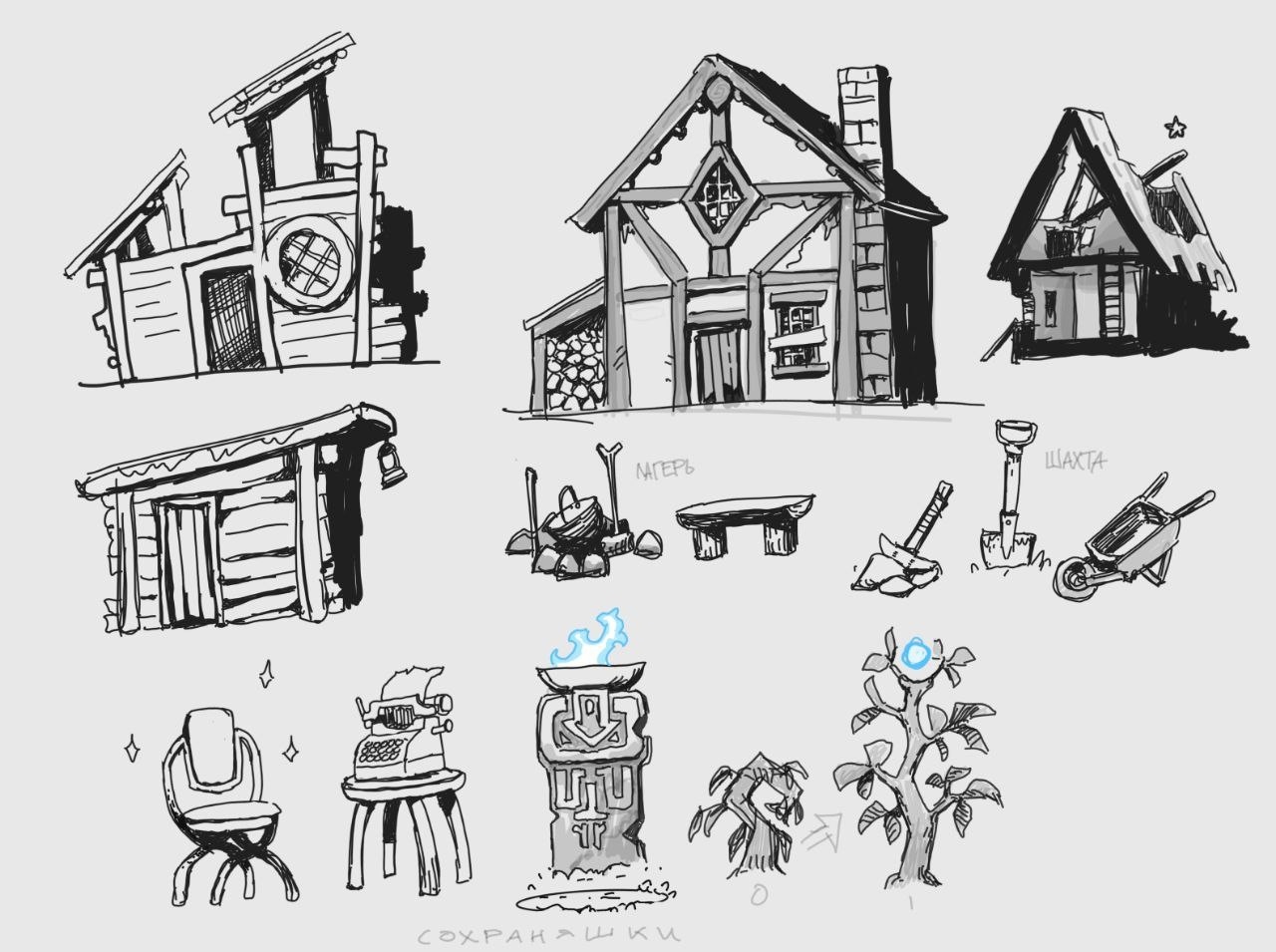
Oct 13, 2023
Steel Division 2 - [EUG] Gal Marcel Bigeard
Hello, hello!
Welcome back to the second Versus of our upcoming new Tribute-style expansion. As you should know by now, this new DLC will bring all remaining Steel Division: Normandy 44 divisions to Steel Division 2.
Let’s welcome to the stage the Allied U.S. 1st Infantry Division “Big Red One” and the Axis German 16. Luftwaffe-Feld-Division.
Please remember that we are still actively testing, so treat all the following as work-in-progress!
The 1st Infantry Division “Big Red One” is an “old school” combat experienced (with lots of World War I veteran cadres) infantry division, featuring very strong infantry and artillery but less armor support compared to other Western Allies infantry divisions.
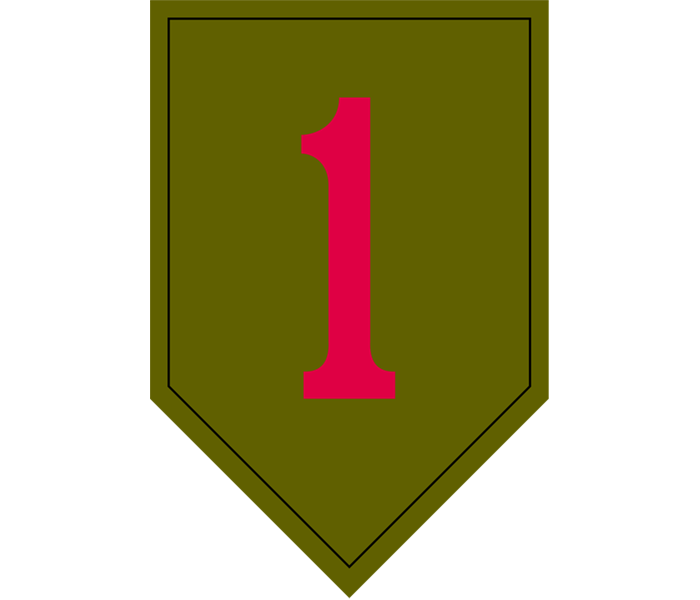
Created in 1917 as part of the American Expeditionary Forces (AEF), the “Big Red One” (BRO) fought with distinction in France, ending the war for occupational duties in Germany. It was one of only four divisions in the U.S. Army to remain active during the interwar years. In 1940, the formation was brought up back to strength, reorganized, and reinforced, being one of the first Army divisions to undergo amphibious training. As one of the best prepared, BRO was first to fight and sent to North Africa, where it landed near Oran in Vichy French Algeria, during Operation Torch.
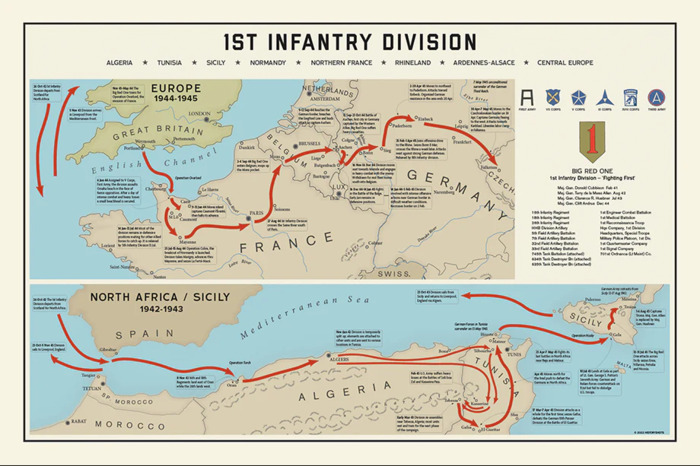
The division further saw action in Tunisia, including the Battle of Kasserine Pass, then landing and campaign of Sicily, before being assigned as one of the assault divisions for D-Day. BRO famously landed on Omaha Beach before battling itself onto shore after suffering serious casualties. It kept on fighting in Normandy. Later on, BRO pursued the retreating German units after the breakout through northern France, all the way to the Siegfried line, before attacking the German city of Aachen. It continued to battle, including the Hurtgen Forrest and Battle of the Bulge, before ending the war on the Czechoslovakian border.
As a sign of its combat prowess, the division gathered an unequaled tally of sixteen Medal of Honors over the course of World War II.
The 1st Infantry Division “Big Red One” deployed in Steel Division: Normandy 44 as part of the free First Blood expansion.
In Steel Division 2, all of BRO’s infantry units (including weapon teams, mortars, recon, leader, infantry, and AT guns) will come with minimum veterancy level 1 and no penalties to availability. Long-range support or vehicles will be standard.
However, most of these units will only be available from Combat Phase B onwards. In Phase A, representing the D-Day assault waves hitting the Normandy beaches, BRO’s infantry will be task-oriented “assault squads.”
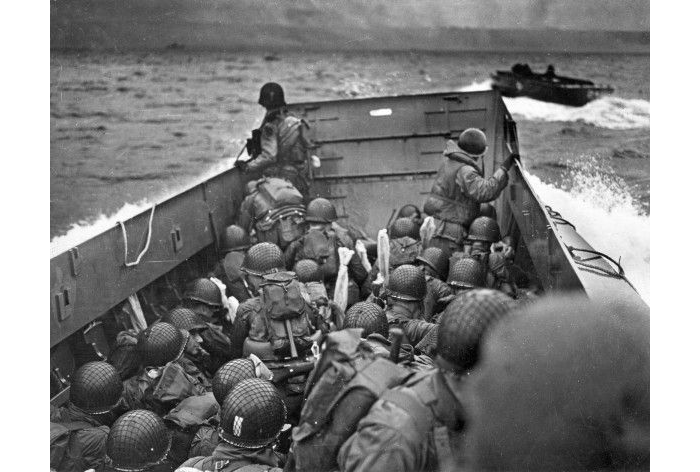
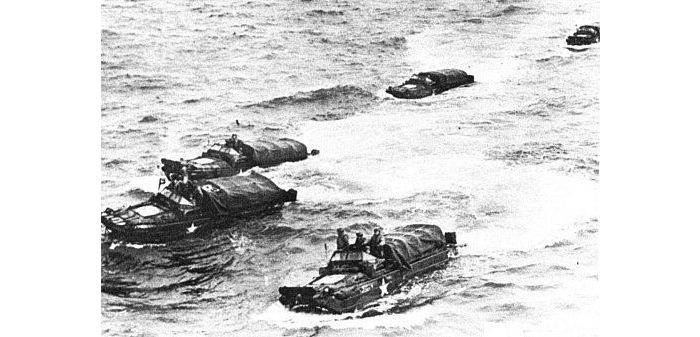
BRO’s armored support was unlucky in the early days of the Normandy campaign. While one of its attached tank battalion’s companies was equipped with M4 DD to support the invasion on the beach, all but two sunk to the bottom of the Channel. Later on D-Day, the rest of the battalion made up of M4A1 and M5A1, landed but within a week were decimated and had to be pulled out.
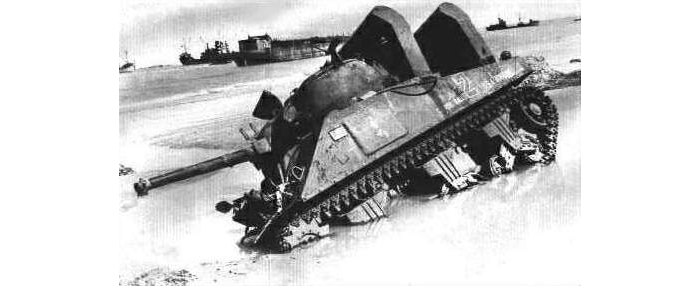
This is why the division’s TANK tab will be somewhat uneven, with only an average amount of slots and all the tank types mentioned above only available from Combat Phase A. The M4A1 (vanilla and command variants) will be unavailable in B before reporting for duty in Combat Phase C again. This represents the refurbished battalion returning to the division. The M4 DD will only be available in A and the M5A1 in Combat Phases A and B.
The SUPP category includes the M4 105 (with the same availability pattern as the M4A1) and the M7 DD (which is a Priest), as well as the usual complement of MGs, supply trucks, commanders and M3 105mm infantry guns.
BRO has organic 57mm and 76mm AT guns, but no tank destroyers. Dedicated tank destroyers were only briefly attached to it, which leads to a handful of B-only M10A1 DESTROYER units.

Recon is pretty standard with only a few slots, filled with classic choices such as JEEP .50, infantry recon squads, and M8.
Let’s go triple AAA now. The Anti-Air units for this division are rather special. You can consider them light, as they only amount to M16 MGMC and BOFORS. However, the latter units were towed to shore by even more M16 MGMC to provide immediate fire support. This means they can be brought in their own cards as towed-transport combos, which means they are more expensive but double the division’s slot value.
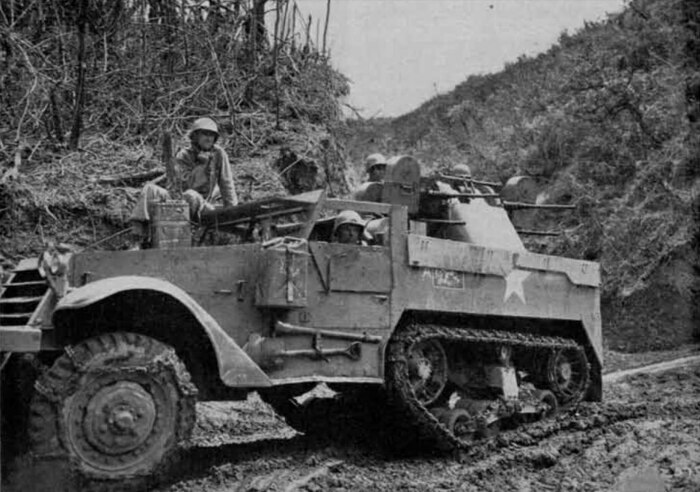
Artillery is the division’s second strong point - after infantry - with plenty of powerful, deadly options. Aside from the usual 81mm and 107mm mortars and M2A1 105mm howitzers (the latter brought ashore by DUKW, doubling as supply trucks), additional support comes from an entire battalion of attached M7 105mm (Priest). Besides, only in Combat Phase A, the USS Texas’ big 356mm naval guns will provide off-map support. Later on in the battle, which means from Combat Phase B onwards, BRO will receive LONG TOM 155mm on-map support.
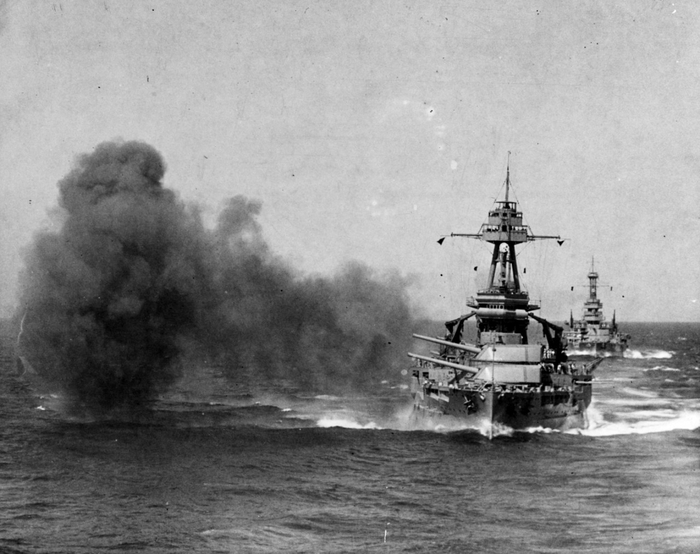
Air support will be pretty decent with P-51 fighters, P-38 fighter-bombers, and new A-20G light bombers. This latter unit is not actually the same model as the Soviet equivalent, but a brand-new one.
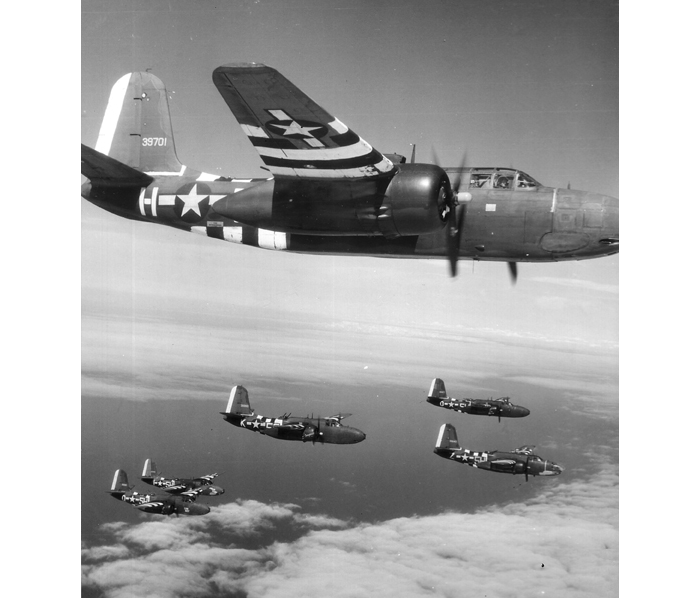
Luftwaffe-Feld-Divisionen can trace their origins back to the winter of 1941 and 42. Meaning “field divisions,” these infantry formations were formed from Luftwaffe with excess military or ground personnel. To counter the constant Soviet attacks, all and every kind of soldier were thrown into battle. At first, the Luftwaffe raised four provisional infantry regiments after a personal appeal for volunteers from Reichsmarschall Göring.
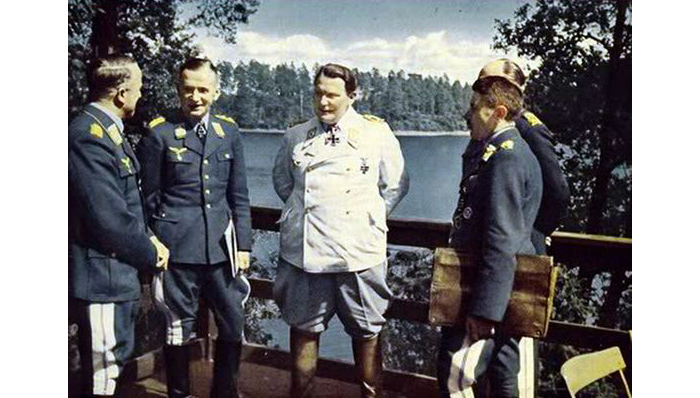
Although inexperienced in ground combat and lacking equipment, the Luftwaffe regiments distinguished themselves well on the Eastern Front. This fate would not befall the subsequent Luftwaffe-Feld-Divisionen raised starting in 1942, including the 16. Luftwaffe Feld Division.
Each Luftwaffe field division was much smaller than its Army counterpart, almost half the size. Their artillery guns were often second rate, and their anti-tank ones were mostly restricted to the smaller caliber. However, they could deploy a large number of Flak 88mm guns. After a disastrous Eastern Front campaign, by November 1943, all remaining Luftwaffe field divisions passed to Heer control and were reorganized along infantry division lines.
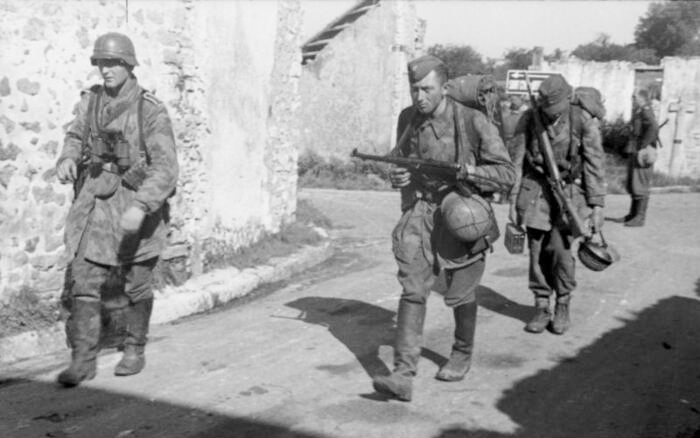
After forming, 16. Luftwaffe Feld Division was sent to the Netherlands for training and coastal defense duties. In 1943, the Army took over before it was moved piecemeal to Normandy and thrown into combat around Caen next to 21. Panzer. A large part of the division was first destroyed during the artillery and aerial bombardment of Operation Charnwood before Operation Goodwood wiped out the remaining units of the 16. Luftwaffe Feld Division. With most officers gone, its back broken, the scant remaining units were absorbed by the 21. Panzer.
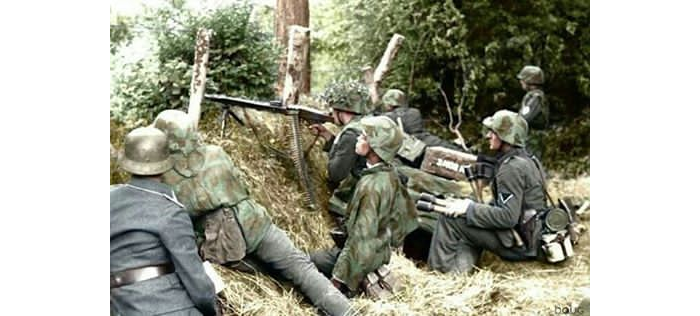
The 16. Luftwaffe was featured in Steel Division: Normandy 44’s expansion Second Wave.
By 1944, the Luftwaffe-Feld-Divisionen had passed under Army command, which organized them by their own standards. The 16. Luftwaffe remained noticeably weaker than regular Wehrmacht infantry divisions when it first arrived in Normandy in early July 1944.
An overview of the divisional state of affairs.
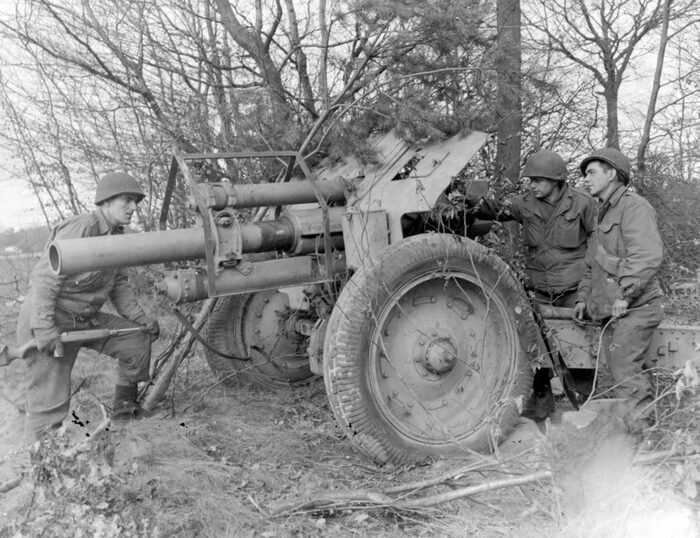
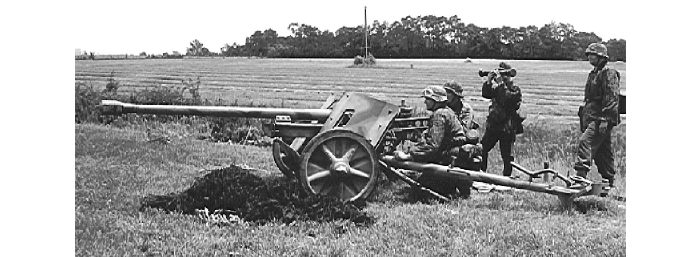
Pretty gloomy, right? Not to worry.
We will beef up the 16. Luftwaffe with some locally sourced detachments. You might remember that we mentioned the number of mighty Königstiger from 21. Panzer had been lowered? They belonged to the s.Panzer-Abteilung 503, which fought alongside both the 21. Panzer and 16. Luftwaffe. The latter will now receive a share of the heavy tanks!
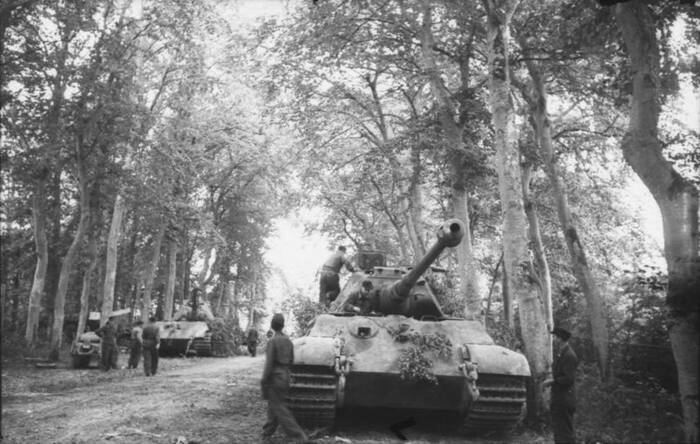
That’s why the TNK category of the division will be cramped, but feature:
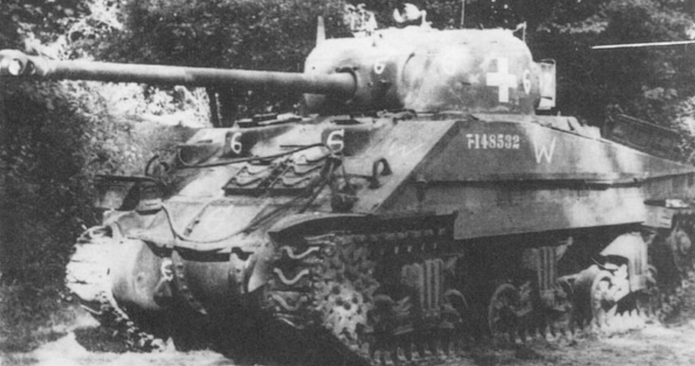
Some other “Beute” units you’ll find here are:
Another important attachment was the III. Flak-Korps, another Luftwaffe unit. These plentiful guns, ranging from 20mm to 88mm, would be the division’s anti-tank shield against the British armored offensives. This means that in-game, the division’s AA tab is significant and expansive.
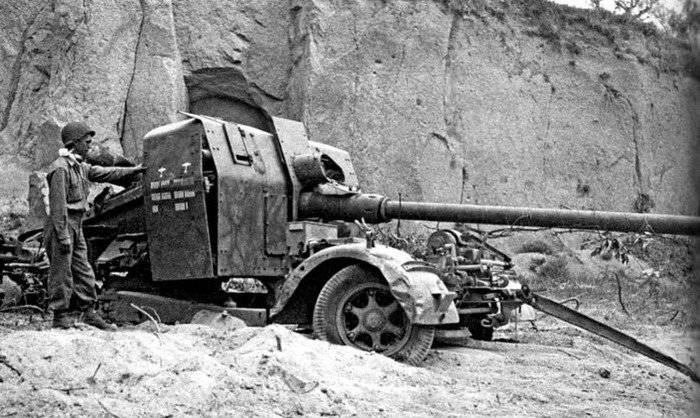
Recon forces are pretty minimalistic, with the usual AUFKLÄRER and FÜSILIERS squads plus motorcycles with side-cars. Sidenote: these recon soldiers are the only ones without the Disheartened trait, and better equipped with the division's few MG-42.
Infantry is a mixed bunch. Plentiful, as expected, but all of them feature the Disheartened trait (except for recon and leader squads). The latter unit will receive the Discipline trait, being Luftwaffe officers and whatnot, more indoctrinated and quick to draw a pistol to force an order. 16. Luftwaffe’s strong point is not its infantry, with poor morale, outdated equipment, and veterancy locked.
The SUPP category includes various MG models (all Disheartened), German or foreign, as well as FLAKPANZER BREN (20mm Flak guns mounted on captured Bren Carrier and used in direct fire support role) and a handful of SDKFZ. 135/1 heavy direct fire SP 150mm guns (both courtey of Baucommando Becker). You’ll also be able to find large 13-man LW-FELDGENDARMERIE squads with both Discipline and Fanatical traits to keep the troops in line.
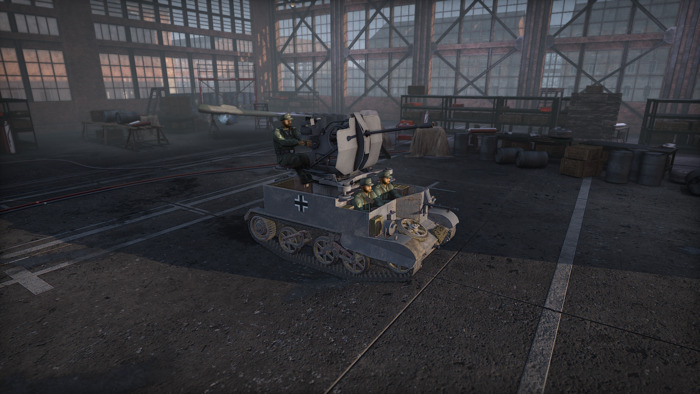
The ART tab is likewise nothing to write home about, but rather average. Lighter Soviet gun pieces double as makeshift anti-tank guns. These units are supported by a handful of attached NEBELWERFER 41, 150mm and K 18 170mm howitzers.
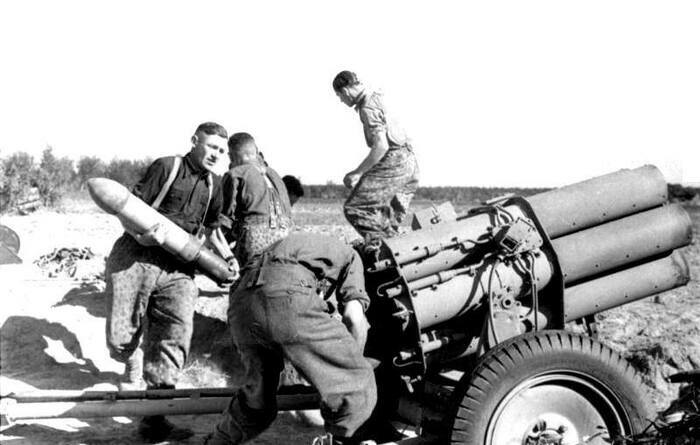
AIR support, on the other hand, will be plentiful, especially in close air support bombers and anti-tank planes. At least one good thing about being a Luftwaffe division.
The 16. Luftwaffe will be a slightly strange division. It is technically an infantry formation, but filled with unreliable and lower quality infantry. However, it can count on a sprinkling of some of the strongest units out there (KÖNIGSTIGER, PANZERJÄGER FIREFLY, Beute 17-PDR, etc.) to provide critical support. It means that the division is highly versatile and unpredictable for both the opponent and the player.
And before people ask: no, the FT-17s won’t make a return. Much like the recon UE630s, these vehicles were rear-area airfield security units added in Steel Division: Normandy ‘44 because they were also “Luftwaffe.” In Steel Division 2, these hopelessly obsolete units have nothing to do near the frontline - nor did they come in sufficient numbers - to justify a unit card.
Keep in mind that the Steel Division: Tribute to Normandy ‘44 is a work-in-progress name. What will this expansion contain?
That’s all for the second Versus. Let us know what you think. We’ll be back next week!
Don’t be shy, join the Steel Division 2 community on our Steam forums. The latest Steel Division 2 news can also be encountered on our Instagram.
Looking for an online game? Visit the Discord server or Reddit page and get involved with the lively Steel Division 2 community!
See you on the battlefield, commander!
Welcome back to the second Versus of our upcoming new Tribute-style expansion. As you should know by now, this new DLC will bring all remaining Steel Division: Normandy 44 divisions to Steel Division 2.
Let’s welcome to the stage the Allied U.S. 1st Infantry Division “Big Red One” and the Axis German 16. Luftwaffe-Feld-Division.
Please remember that we are still actively testing, so treat all the following as work-in-progress!
The 1st Infantry Division “Big Red One” History
The 1st Infantry Division “Big Red One” is an “old school” combat experienced (with lots of World War I veteran cadres) infantry division, featuring very strong infantry and artillery but less armor support compared to other Western Allies infantry divisions.

Created in 1917 as part of the American Expeditionary Forces (AEF), the “Big Red One” (BRO) fought with distinction in France, ending the war for occupational duties in Germany. It was one of only four divisions in the U.S. Army to remain active during the interwar years. In 1940, the formation was brought up back to strength, reorganized, and reinforced, being one of the first Army divisions to undergo amphibious training. As one of the best prepared, BRO was first to fight and sent to North Africa, where it landed near Oran in Vichy French Algeria, during Operation Torch.

The division further saw action in Tunisia, including the Battle of Kasserine Pass, then landing and campaign of Sicily, before being assigned as one of the assault divisions for D-Day. BRO famously landed on Omaha Beach before battling itself onto shore after suffering serious casualties. It kept on fighting in Normandy. Later on, BRO pursued the retreating German units after the breakout through northern France, all the way to the Siegfried line, before attacking the German city of Aachen. It continued to battle, including the Hurtgen Forrest and Battle of the Bulge, before ending the war on the Czechoslovakian border.
As a sign of its combat prowess, the division gathered an unequaled tally of sixteen Medal of Honors over the course of World War II.
The 1st Infantry Division “Big Red One” Combat Power
The 1st Infantry Division “Big Red One” deployed in Steel Division: Normandy 44 as part of the free First Blood expansion.
In Steel Division 2, all of BRO’s infantry units (including weapon teams, mortars, recon, leader, infantry, and AT guns) will come with minimum veterancy level 1 and no penalties to availability. Long-range support or vehicles will be standard.
However, most of these units will only be available from Combat Phase B onwards. In Phase A, representing the D-Day assault waves hitting the Normandy beaches, BRO’s infantry will be task-oriented “assault squads.”

- ASSAULT TEAM - with Garands, BARs, flamethrower, and smoke grenades.
- ASSAULT BREACHER - with Thompsons, Garands, TNT, and smoke grenades.
- ASSAULT LEADER - with Thompsons, Carbines, scoped Springfield, and Bazooka.
- ASSAULT FIRE SUPPORT - with Carbines and two M1919A6 LMGs.
- ASSAULT BUSTER - with Carbines and “Rocketgun” (HE bazooka for bunker-busting).

Recon, Armor, Support, Anti-Tank
BRO’s armored support was unlucky in the early days of the Normandy campaign. While one of its attached tank battalion’s companies was equipped with M4 DD to support the invasion on the beach, all but two sunk to the bottom of the Channel. Later on D-Day, the rest of the battalion made up of M4A1 and M5A1, landed but within a week were decimated and had to be pulled out.

This is why the division’s TANK tab will be somewhat uneven, with only an average amount of slots and all the tank types mentioned above only available from Combat Phase A. The M4A1 (vanilla and command variants) will be unavailable in B before reporting for duty in Combat Phase C again. This represents the refurbished battalion returning to the division. The M4 DD will only be available in A and the M5A1 in Combat Phases A and B.
The SUPP category includes the M4 105 (with the same availability pattern as the M4A1) and the M7 DD (which is a Priest), as well as the usual complement of MGs, supply trucks, commanders and M3 105mm infantry guns.
BRO has organic 57mm and 76mm AT guns, but no tank destroyers. Dedicated tank destroyers were only briefly attached to it, which leads to a handful of B-only M10A1 DESTROYER units.

Recon is pretty standard with only a few slots, filled with classic choices such as JEEP .50, infantry recon squads, and M8.
Anti-Air, Artillery, Air
Let’s go triple AAA now. The Anti-Air units for this division are rather special. You can consider them light, as they only amount to M16 MGMC and BOFORS. However, the latter units were towed to shore by even more M16 MGMC to provide immediate fire support. This means they can be brought in their own cards as towed-transport combos, which means they are more expensive but double the division’s slot value.

Artillery is the division’s second strong point - after infantry - with plenty of powerful, deadly options. Aside from the usual 81mm and 107mm mortars and M2A1 105mm howitzers (the latter brought ashore by DUKW, doubling as supply trucks), additional support comes from an entire battalion of attached M7 105mm (Priest). Besides, only in Combat Phase A, the USS Texas’ big 356mm naval guns will provide off-map support. Later on in the battle, which means from Combat Phase B onwards, BRO will receive LONG TOM 155mm on-map support.

Air support will be pretty decent with P-51 fighters, P-38 fighter-bombers, and new A-20G light bombers. This latter unit is not actually the same model as the Soviet equivalent, but a brand-new one.

The 16. Luftwaffe Feld Division
Luftwaffe-Feld-Divisionen can trace their origins back to the winter of 1941 and 42. Meaning “field divisions,” these infantry formations were formed from Luftwaffe with excess military or ground personnel. To counter the constant Soviet attacks, all and every kind of soldier were thrown into battle. At first, the Luftwaffe raised four provisional infantry regiments after a personal appeal for volunteers from Reichsmarschall Göring.

Although inexperienced in ground combat and lacking equipment, the Luftwaffe regiments distinguished themselves well on the Eastern Front. This fate would not befall the subsequent Luftwaffe-Feld-Divisionen raised starting in 1942, including the 16. Luftwaffe Feld Division.
Each Luftwaffe field division was much smaller than its Army counterpart, almost half the size. Their artillery guns were often second rate, and their anti-tank ones were mostly restricted to the smaller caliber. However, they could deploy a large number of Flak 88mm guns. After a disastrous Eastern Front campaign, by November 1943, all remaining Luftwaffe field divisions passed to Heer control and were reorganized along infantry division lines.

After forming, 16. Luftwaffe Feld Division was sent to the Netherlands for training and coastal defense duties. In 1943, the Army took over before it was moved piecemeal to Normandy and thrown into combat around Caen next to 21. Panzer. A large part of the division was first destroyed during the artillery and aerial bombardment of Operation Charnwood before Operation Goodwood wiped out the remaining units of the 16. Luftwaffe Feld Division. With most officers gone, its back broken, the scant remaining units were absorbed by the 21. Panzer.

The 16. Luftwaffe Feld Division
The 16. Luftwaffe was featured in Steel Division: Normandy 44’s expansion Second Wave.
By 1944, the Luftwaffe-Feld-Divisionen had passed under Army command, which organized them by their own standards. The 16. Luftwaffe remained noticeably weaker than regular Wehrmacht infantry divisions when it first arrived in Normandy in early July 1944.
An overview of the divisional state of affairs.

- Its entire artillery regiment was equipped with captured Soviet guns. This means F-22 76,2mm and M30 122mm gun-howitzers instead of more powerful German-made 105mm and 150mm.
- Some of its anti-tank guns were the old medium PAK 38 50mm with only part of PAK 40 75mm.
- A complete lack of IG 18 or IG 33 infantry support guns.
- Its assault gun support was also lacking (only two old vehicles out of nine promised). In-game, this will be represented by the STUG III F/8 tank destroyer in the AT category.
- Particularly shameful for a Luftwaffe division, the 16. Luftwaffe only had a dozen light FLAK 20mm guns for anti-air defenses.
- As a cherry on the cake, the average soldier’s morale was low.

Pretty gloomy, right? Not to worry.
The 16. Luftwaffe Feld Division beefed up
We will beef up the 16. Luftwaffe with some locally sourced detachments. You might remember that we mentioned the number of mighty Königstiger from 21. Panzer had been lowered? They belonged to the s.Panzer-Abteilung 503, which fought alongside both the 21. Panzer and 16. Luftwaffe. The latter will now receive a share of the heavy tanks!

That’s why the TNK category of the division will be cramped, but feature:
- Both TIGER E and KÖNIGSTIGER.
- STUG III G in both Combat Phase A and B.

Some other “Beute” units you’ll find here are:
- A Combat Phase A-only card of British 17-PDR captured by the 21. Panzer while fighting in Colombelles alongside the 16. Luftwaffe. Three were captured and one reused, but they would be pointless with the 21. Panzer, hence their new owners being the 16. Luftwaffe.
- A few PANZERJÄGER BREN. These are Bren Carriers captured at Dunkirk and worked on by Baucommando Becker to have them carry (also captured) Belgian 47mm AT guns. While it is difficult to pinpoint the formation these units belonged to, these vehicles clearly fought their last battle in Normandy.
The 16. Luftwaffe Feld Division’s extra toys
Another important attachment was the III. Flak-Korps, another Luftwaffe unit. These plentiful guns, ranging from 20mm to 88mm, would be the division’s anti-tank shield against the British armored offensives. This means that in-game, the division’s AA tab is significant and expansive.
- FLAK 36 37mm. These will be available in earlier phases. Later on, FLAK 43 37mm will replace them towed by heavy NAG 4500 trucks, themselves armed with triple Drillinge 15mm AA machine guns.
- FLAK 37 88mm. This currently in-game unit will be renamed. Some batteries of the “true” FLAK 41 88mm will be introduced in the division. This later variant of the gun had a lower profile, better rate of fire and anti-tank performance.
- Finally, some FLAKZWILLING 37mm twin guns.

Recon, Infantry, Support, Art, and Air
Recon forces are pretty minimalistic, with the usual AUFKLÄRER and FÜSILIERS squads plus motorcycles with side-cars. Sidenote: these recon soldiers are the only ones without the Disheartened trait, and better equipped with the division's few MG-42.
Infantry is a mixed bunch. Plentiful, as expected, but all of them feature the Disheartened trait (except for recon and leader squads). The latter unit will receive the Discipline trait, being Luftwaffe officers and whatnot, more indoctrinated and quick to draw a pistol to force an order. 16. Luftwaffe’s strong point is not its infantry, with poor morale, outdated equipment, and veterancy locked.
The SUPP category includes various MG models (all Disheartened), German or foreign, as well as FLAKPANZER BREN (20mm Flak guns mounted on captured Bren Carrier and used in direct fire support role) and a handful of SDKFZ. 135/1 heavy direct fire SP 150mm guns (both courtey of Baucommando Becker). You’ll also be able to find large 13-man LW-FELDGENDARMERIE squads with both Discipline and Fanatical traits to keep the troops in line.

The ART tab is likewise nothing to write home about, but rather average. Lighter Soviet gun pieces double as makeshift anti-tank guns. These units are supported by a handful of attached NEBELWERFER 41, 150mm and K 18 170mm howitzers.

AIR support, on the other hand, will be plentiful, especially in close air support bombers and anti-tank planes. At least one good thing about being a Luftwaffe division.
16. Luftwaffe in Summary
The 16. Luftwaffe will be a slightly strange division. It is technically an infantry formation, but filled with unreliable and lower quality infantry. However, it can count on a sprinkling of some of the strongest units out there (KÖNIGSTIGER, PANZERJÄGER FIREFLY, Beute 17-PDR, etc.) to provide critical support. It means that the division is highly versatile and unpredictable for both the opponent and the player.
And before people ask: no, the FT-17s won’t make a return. Much like the recon UE630s, these vehicles were rear-area airfield security units added in Steel Division: Normandy ‘44 because they were also “Luftwaffe.” In Steel Division 2, these hopelessly obsolete units have nothing to do near the frontline - nor did they come in sufficient numbers - to justify a unit card.
Steel Division: Tribute to Normandy ‘44
Keep in mind that the Steel Division: Tribute to Normandy ‘44 is a work-in-progress name. What will this expansion contain?
- It will include ALL the missing Steel Division: Normandy 44 divisions, including those that were featured in subsequent DLCs (First Blood, Second Wave, Back to Hell).
- This means 7 Axis and 7 Allied divisions, with one Allied formation being brand-new!
- Get ready to take command of the Allied US 101st Airborne Division, US 4th Armored Division, US 1st Infantry Division "Big Red One", UK Guards Armoured Division, UK 7th Armoured Division “Desert Rats” and French Demi-Brigade SAS. The 4th Canadian Armoured Division will be brand-new.
- On the Axis side, the new Tribute expansion will feature the 91. Luftlande-Division, 716. Infanterie-Division, 1. SS-Panzerdivision "LSSAH", 16. Luftwaffe-Feld-Division, 9. Panzerdivision, 2. Panzerdivision, and Festungs Gross-Paris.
- Get ready to take command of the Allied US 101st Airborne Division, US 4th Armored Division, US 1st Infantry Division "Big Red One", UK Guards Armoured Division, UK 7th Armoured Division “Desert Rats” and French Demi-Brigade SAS. The 4th Canadian Armoured Division will be brand-new.
- This will result in the biggest Tribute expansion for Steel Division 2.
- It will contain only divisions. As this is a recurring question, the answer remains the same. NO new maps!
- The new divisions will be reworked to take advantage of Steel Division 2’s mechanics, traits, equipment, etc. They will be closer to historical reality and maybe different regarding unit disposition, materiel, weapons, etc. The new divisions will keep their main features and playstyles, of course.
See you on the battlefield
That’s all for the second Versus. Let us know what you think. We’ll be back next week!
Don’t be shy, join the Steel Division 2 community on our Steam forums. The latest Steel Division 2 news can also be encountered on our Instagram.
Looking for an online game? Visit the Discord server or Reddit page and get involved with the lively Steel Division 2 community!
See you on the battlefield, commander!







